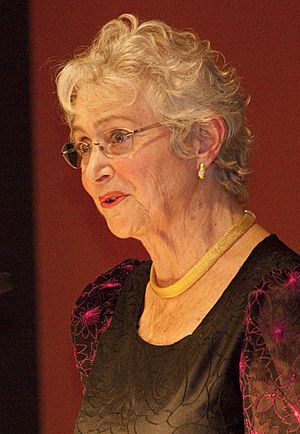Lorna Casselton facts for kids
Quick facts for kids
Lorna Casselton
|
|
|---|---|

Casselton in 2010.
|
|
| Born |
Lorna Ann Smith
18 July 1938 Rochford, Essex, England
|
| Died | 14 February 2014 (aged 75) Oxford, England
|
| Alma mater | University College London |
| Known for | Genetic and molecular analysis of mushrooms |
| Spouse(s) |
|
| Awards | |
| Scientific career | |
| Institutions |
|
| Thesis | The production, behaviour and genetics of diploids of Coprinus lagopus (1964) |
| Doctoral advisor | Dan Lewis |
Lorna Ann Casselton (born July 18, 1938 – died February 14, 2014) was an important British scientist. She was a professor who studied the genetics of fungi, especially mushrooms. She worked at the University of Oxford and was known for her detailed studies of mushrooms like Coprinus cinereus and Coprinus lagopus.
Contents
Early Life and Education
Lorna Casselton was born on July 18, 1938, in Rochford, England. Her parents were William Charles Henry Smith and Cecile Smith. Her family lived on a small farm, and her father was very interested in natural history and genetics. This helped Lorna and her sister, Pauline, become interested in biology.
Lorna went to Southend High School for Girls. After high school, she studied at University College London. There, she earned a Bachelor of Science (BSc) degree in botany. She continued her studies and received her Doctor of Philosophy (PhD) degree in 1964.
Academic Career and Research
Lorna Casselton started her career as a lecturer and researcher. Her first job was at Royal Holloway College in London. She became a Professor of Genetics at Queen Mary University of London in 1989. She held this position until 1991.
Later, she received special research awards called Postdoctoral and Senior Research Fellowships. These awards helped her continue her important work. In 1997, she was made a Professor of Fungal Genetics at the University of Oxford.
Professor Casselton was also a Fellow at St Cross College, Oxford, from 1993 to 2003. She became an Honorary Fellow at St Hilda's College, Oxford, in 2000.
Working with the Royal Society
Lorna Casselton was a member of the Royal Society's Council from 2002 to 2003. The Royal Society is a very old and respected group of scientists. She rejoined the Council in 2006. This time, she was the Vice-President and Foreign Secretary. In this role, she traveled to many countries. She gave important lectures in places like South Africa and India. During her three and a half years in this job, she visited 27 different countries.
Her research focused on the genetic and molecular analysis of mushrooms. This means she studied how mushrooms grow, reproduce, and inherit traits at a very detailed level. Her work helped scientists understand more about these fascinating organisms.
Awards and Recognition
Lorna Casselton received many awards for her important contributions to science:
- In 1999, she became a Fellow of the Royal Society. This is a very high honor for scientists in the UK.
- In 2008, she became a member of the Academia Europaea. This is an organization that brings together leading scientists from across Europe.
- She received honorary Doctor of Science degrees from Queen Mary University of London in 2009 and University College London in 2010. An honorary degree is given to someone to recognize their great achievements.
- In 2012, she was awarded the Commander of the Order of the British Empire (CBE). This is a special award from the British monarch for people who have made a big difference.
- In 2002, she received an Honorary Membership of the British Mycological Society. This society is for people who study fungi.
Later Life
Lorna Casselton passed away on February 14, 2014, after a short illness. She was 75 years old. Her work continues to inspire new scientists who study fungi and genetics.

